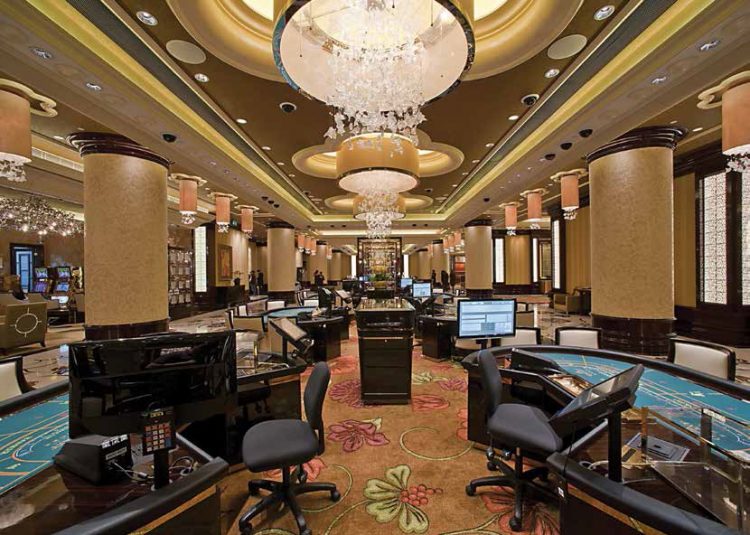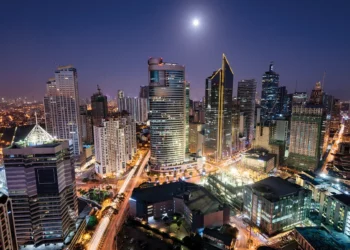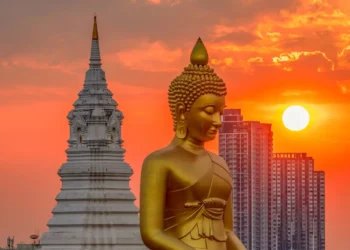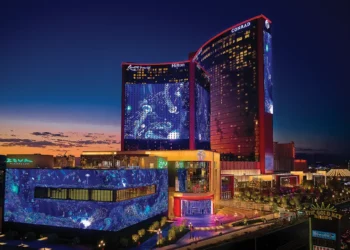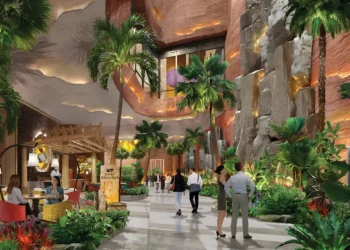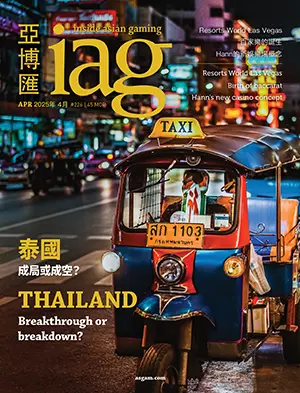Casino architecture and design is busily adapting to an evolving gaming landscape
By Paul Doocey
Like many facets of the casino industry, architecture and design were forced to take a back seat to more immediate economic concerns as individual properties as well as entire gaming markets slogged through a protracted recovery from the worldwide financial crisis, a business catastrophe that the gaming industry finally appears to be putting in the rearview mirror.
Primarily fueled by a casino development boom in Asia and South America and continuing opportunities in the more established American and European marketplaces, casino architects and designers are once again busily translating operator dreams and desires to physical reality. But to say it is back to business as usual after a five-year detour would be something of a misnomer; many gaming markets and consumers have undergone a profound evolution over the past half decade, and these changes are having an impact on bricks-and-mortar properties and the people who design and develop them.
Paul Steelman, CEO of Steelman Partners, a Las Vegas-based international architectural firm that has designed projects in over 50 countries, has felt these seismic shifts, and has even identified the one that may be having the biggest current influence. Speaking to industry executives at September’s Global Gaming Expo in Las Vegas, he said, “Whatever jurisdiction we’re working in and whatever language we are speaking, one item is always being brought up with the upmost importance: you must design this property to appeal to the Chinese gambler.”
The growing influence of the Asian gambler on casino design was just one of many topics covered by speakers who participated in the design sessions at G2E. Here are some of the trends with the potential to impact current and future casino design that were discussed and dissected at the show.
China Trade
Asia continues to be the nexus of current casino development, with multiple projects in various stages of development throughout the region. Indeed, Steelman Partners alone has its hand in dozens of potential Asian developments, a list that includes the secondphase development of the Ho Tram Strip in Vietnam, as well as the California-inspired design for Dragon Hill, which will be located in the northern part of the country, and the recently opened Solaire Resort & Casino in the Philippines. Steelman is also involved in creating a master development plan for PAGCOR casinos in Manila. Other projects include a proposed gaming area in Cambodia, which will include a massive theme park and 10-12 casinos; a gaming property on the Taiwanese island of Matsu; a master plan for casino development in Vladivostok, Russia; and casino expansion and refurbishments in Sydney and other Australian cities.
The taste for casino development throughout the region is such that massive gaming projects are being announced in some pretty esoteric places, such as Yap Island, roughly 800 miles from Manila, where a Chinese developer announced plans to build the first underwater casino.
Still, no matter where these properties are based, they are being developed with one type of consumer in mind: the affluent Chinese gambler. Mr Steelman was not the only architect or operator to notice this trend.
“Everyone is designing for the Chinese customer,” said Peter Wu, a 20-year gaming veteran who worked for casinos in Macau and Singapore and was most recently the senior vice president of international casino marketing alliances for Baha Mar in The Bahamas. “Everyone is looking to capture the Chinese customer. The challenge is that there are a lot of important elements that need to be included in a casino’s design to accomplish this task.”
To start, the casino developer and designer must be aware of the type of consumer they want to attract. Traditionally in Macau, Singapore and elsewhere in Asia there have been two extremes: the mass-market gambler or the high-limit VIP. Recently, however, a new market segment has emerged that most developers are now targeting: the premium mass-market. According to Mr Wu, the premium mass-market customer tends to play with cash and bets on a comparable level as a VIP.
“These players were lumped into the mass market but played like VIPs, without being treated like VIPs,” he said. “They were an untapped customer base and gaming companies are now starting to show them the love.”
From a development standpoint, what needs to be considered when designing a property to attract the premium mass-market Chinese gambler? Mr Wu listed five points:
• Access—When a Chinese gambler comes to a casino resort, they are primarily interested in one thing and one thing only: to gamble. They demand quick and easy access to table games and the amenities needed to play the games longer. “While at the Sands Macao, I noticed the busiest area of the casino was a tight space sandwiched between the noodle shop, restrooms, cage and hotel lifts,” Mr Wu said. “When it comes to gambling, the Chinese are all business, whatever market you are in. In some casinos you can actually see the wear patterns in the carpet where customers have cut corners to make a more direct beeline to the tables and slot machines.”
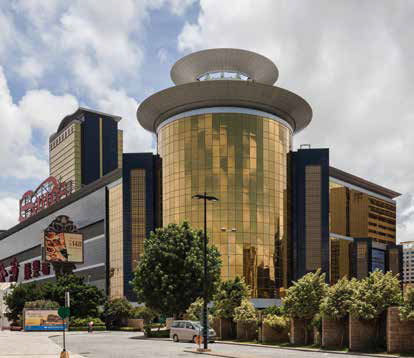
Sands Macau pioneered many of the VIP features now standard in most Asian casinos.
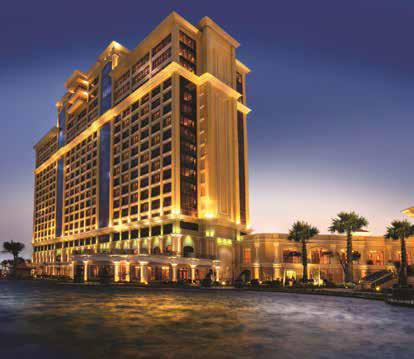
Vietnam’s recently opened Ho Tram strip with amenities designed to appeal to the premium mass-market player.
• Convenience—Chinese gamblers insist on having vital services at hand so they can remain longer at the machines or tables. For example, Mr Wu described having to build special, extra-wide hightech slot bases for the VIP gaming salons at Sands Macao so the premium players would have space to place bags, recharge phones, and store valuable items while playing. “They would charge their cell phones while playing the slot,” Mr Wu said. “These are all elements of convenience that kept them in the salon and at the machine so they could gamble more.”

• Luxury—The premium mass-market player may come to gamble and be all business when doing so, but they also seek status at gaming resorts, and the trappings of luxury are very important to them. “The premium mass-market player likes to stay four-star, eat five-star and aspires to be six-star,” Mr Wu said. “That is key to a product offering. They may be too busy gambling to enjoy the luxury, but it important to them that it is available to family and friends.”
• Entertainment—The Chinese premium customer wants a facility to offer a whole host of entertainment options; not for themselves, but for the family and guests that may be staying with them. “The premium player expects there to be family-style entertainment at the resort, and to be comped with the best tickets and seats” Mr Wu said. “It gives family and friends something to do so they can focus on the business of gambling.”
• Intimacy—Not surprising, considering the crowded nature of many Asian cities, most premium mass-market players prefer to gamble in private areas that offer a lot of space; which might explain the boom in high-limit salon development taking place at casinos in Macau and throughout Asia. “The VIP gaming salons have everything now,” Mr Wu said. “Bathrooms, showers, tubs, massages—all the comforts. Having all these items is very important to the customer.”

Entertainment, in the form of celebrity chef restaurants or oneof- a-kind attractions, is another key to attracting Generations X and Y to the resort experience.
That’s Entertainment
While many Asian gaming projects continue to max out on size, scope and offerings, casino development elsewhere in the world is taking a different tack, especially in the mature gaming markets of the US and Europe. Here, greater attention is being paid to market segmentation and designing facilities to appeal to a specific group of consumers.
“You really need to understand who your customer is and then develop the offering to appeal to them from the outset,” said Oliver Lovat, a partner with London-based Puji Capital. “This market segmentation has already occurred in London and is now happening in Las Vegas and will probably come to Macau at some point. When you develop a resort today, you need to find a strategic position it can successfully operate from. There is no more ‘build it and they will come,’ where the developer decides for the customer what the customer wants. ”
In the US, the segment that seems to be garnering the most attention from developers in established markets are the Generation X and Y consumers, who are desperately needed to replace a quickly aging player base. It also helps that these groups have already proven they can be lucrative to casino resorts if they so desire—a recent article in The New Yorker delved into the Las Vegas dance club and DJ scene and described how these facilities were generating millions of dollars in yearly revenue for gaming properties.
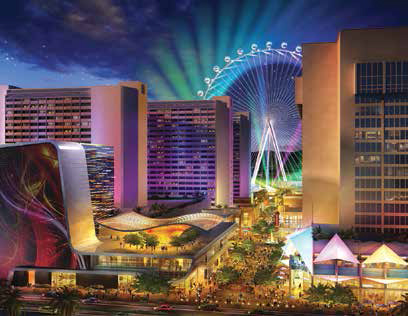
The LINQ, Caesars Entertainment’s US$550 million open-air retail, dining and entertainment district located on the Las Vegas Strip, will open its first phase this month.
To attract younger clientele, future casino resorts will have to be designed with something in mind besides the casino; in a word, entertainment. “Ask a 50-year-old casino resort customer what they expect from the resort experience and they will answer a good players club, a desire to be comped, better odds at the machines and so on,” Lovat said. “Ask the same question to someone from Generation X or Y, and they’ll say a good bar or a premium location.”
Indeed, non-gaming amenities are starting to take precedence in casino design. “If tax rates allow, we will feature more restaurants and entertainment activities in our designs,” Mr Steelman said. “Some of the new facilities on the drawing board feature up to 70 restaurants.”
Some gaming companies have already taken the step to design new projects that trumpet entertainment over everything else. For example, The LINQ, Caesars Entertainment’s $550 million open-air retail, dining and entertainment district located on the Las Vegas Strip, is proceeding as planned and will open its first phase this month, according to Jon Gray, a Caesars official who spoke at G2E.
Mr Gray, who is vice president and general manager of The LINQ, said the project aims to attract a retail mix that includes new market concepts, such as the 78,000-square-foot Brooklyn Bowl concert venue, in addition to successful familiar brands such as Sprinkles Cupcakes and the Titled Kilt bar. The goal of these attractions: to entice younger clientele to visit.
“We are really going after the Gen X and Gen Y consumers with The LINQ,” Mr Gray said. “There are studies that show these generations will comprise over 50 percent of Las Vegas visitor volume by 2015. We are spending $550 million on this project; our first big step toward providing specific retail, dining and entertainment for Gen X and Y consumers.”
So far, the leasing of The LINQ has exceeded expectation, with retailers willing to pay above pro forma rents to be part of the project, according to Mr Gray. “What we are pushing for is a lot of personality to come alive in the storefronts and signage points,” he said. “We have a lot of great tenants coming in and putting their best foot forward and that means there will be a lot of great energy there.”
The remainder will come on line by 28th February, according to Mr Gray. The High Roller—a 550-foot-tall wheel that will act at the primary entertainment attraction for the project— will open sometime in the first half of 2014, once it has passed a rigorous testing procedure. The High Roller will have 28 cabins attached to the wheel, each of which can carry 40 people. It will take 30 minutes for one full revolution, which means upwards of 2,200 people can ride the attraction each hour.
“It is an engineering marvel,” Mr Gray said. “The same group that engineered it also did the Singapore Flyer and the London Eye, which was meant to be a temporary installation but became the second most popular tourist attraction in London. We learned from these projects. The entire rim of the wheel will be lit at night and each cabin will have exterior lighting through a package we can control. The whole thing will be very visual and stunning both day and night. It will become an icon on the Las Vegas Strip.”
Reprinted with permission from Casino Journal.
Models of Efficiency

Architects and designers need to consider maximizing productivity across the entire casino resort enterprise
By Kris Irwin, JCJ Architecture
When thinking about casino efficiency, one naturally thinks of energy. It’s undoubtedly one of the most crucial aspects to creating a truly efficient casino resort, but it takes more than just that for a property to be considered truly efficient.
Having had the unique experience of working on the practice and operational side of facility design, I know first-hand that a great design team excels in delivering unmatched patron, operator and employee experiences in the most economical fashion, and ultimately, a great casino resort facility is one that provides efficiencies in all three areas.
Understanding and meeting the needs and expectations of the patron is the most significant measure of a casino’s success. The experience should be seamlessly memorable and the highest priority for all members of the development and design team.
One way to achieve this is to ensure patrons can efficiently maneuver from each space within the venue without having to backtrack or walk long distances. The layout of a casino resort’s front-of- house area is critical. Amenities such as restrooms, relaxation venues, dining and entertainment are best located so the patron flows easily in and out of gaming areas. A successful guest experience ensures patrons can easily find a favorite slot machine or table game, and also effortlessly obtain a much-needed beverage or food.
Wild Horse Pass Hotel & Casino was designed with this concept in mind. As the first casino to bring Vegas-style gaming to the greater Phoenix, Arizona, area, Wild Horse Pass’ gaming floor is centrally located, creating easy access to a full complement of dining and entertainment opportunities around its perimeter. Similar texture, materiality and movement throughout the casino pay homage to the owners’ desert-dwelling Gila River Indian community. Shades of blue contrast the earthen tones, similar to water upon the desert floor; crystal chandeliers cascade from the sky to reflect the summer monsoon; and at night, the hotel façade’s vertical stream of blue reaches toward the curve of the sky. Together, these textures and visual movements connect the gaming floor to the outside areas, lounges and theater in a manner that does not overwhelm or compete with the overall concept. This layout and design continuity not only physically moves patrons between spaces efficiently, but easily connects each individual experience to the overall casino resort visit.
Employee Consideration
When designers understand the needs and challenges of employees, they can actually increase productivity and effectiveness in the most mundane and routine of tasks. Casino design has always centered on the patron; however, a good designer will look at ways to accommodate both. Designing a more accessible and efficient work environment creates a more positive experience for employees and thus boosts operational output.
A few examples of inefficient work environments include placing employee parking, entry and clock-in locations remote from their actual working space. This creates immense inefficiencies in employee productivity as well as associated operational costs. The solution? Electronic monitoring and access points eliminate the need for a single security-guarded point-of-entry for employees. This allows resorts to increase productivity by shortening the arrival sequence through multiple employee entries and parking areas discretely located around the perimeter of the facility.
Additionally, strategically located areas for team meetings between work shifts, in lieu of one location, decreases the time it takes employees to gather and disperse to their task locations as well as facilitates the supervisor’s ability to oversee and allocate tasks to their staff. Walt Disney Parks and Resorts is one of the best practitioners of employee efficiency. Its famous theme park utility tunnels allow employees to freely and discreetly move throughout the workspace, creating an improved and more productive routine for employees without affecting guest experience. Another prime example is Genting-owned cruise ships, where the design process meticulously takes into account all employee needs and activities. Specifically, the company researched the number of steps every employee would have to take aboard the ship to create maximum efficiency and employee interactions across all operations.
Economic Realities
Design choices—such as building materials selection, installation and maintenance—can create a significant economic impact for casinos as well as help operators to understand the replacement requirements of materials, finishes and building systems. Looking at both holistically can provide long-term economic efficiencies for the building owner.
As those who’ve worked on the owner’s side know, selecting poorly engineered or less-than-durable materials comes with a heavy price tag. Alternatively, using the right, durable finishes not only creates a fresh look for a longer period of time, but it also decreases upkeep, serving as an added protection to exposed corners and materials. Additionally, direct engagement and early dialogue between the design team and the operations and maintenance staff about how a facility will be maintained can lead to the development of simple strategies and design choices that increase the durability and lifespan of materials. Bringing the individuals with on-theground knowledge to the table ensures early identification of the needs and challenges of the space. This allows the owner/designer team to implement a collaborative solution prior to opening day.
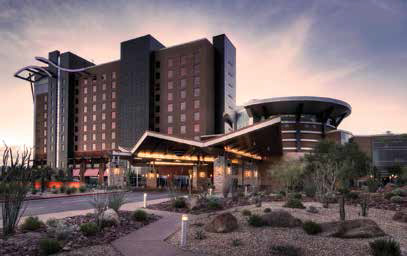
Not only does Wild Horse Pass Hotel & Casino showcase efficient design, it was also modeled to reflect the culture and heritage of the Gila River Indian community.
The owners of the Wild Horse Pass Hotel & Casino engaged in a vigorous dialogue with our design team about not only the visual, but also the functional aspects of materials, fixtures and furnishings. Without compromising design, our team was able to place costefficient, durable HVAC and wiring for the casino’s gaming equipment under the floor to improve the air quality of the space. And for the price-conscious owner/designer teams, sometimes all it takes is a little creativity to produce an innovative and visually pleasing environment. At Saratoga Casino located in Blackhawk, Colorado, for example, glass water bottles from the Saratoga Springs water company were repurposed to create an elaborate and decorative chandelier.
Listen and Learn
One of the most successful strategies for casino owners is to implement deep, wide-ranging and active engagement throughout the entire design process. And the process should not be limited to just the designers and high-ranking managers and executives. Doing so limits your ability to create a truly efficient casino. And listening is not enough. Learning from all involved stakeholders and expecting tangible results from that dialogue is the only way to ensure that facilities will meet collective efficiency goals.
At JCJ, each client participates in multiple, integrated sessions where they share their story and their individual visions of what they want their facility to become. Listening to their vision for the space and collaboratively exploring design solutions creates greater buy-in, respect and adoption. Additionally, owners of facilities that embark on the design process alongside the architect develop a sense of ownership and pride in their facility. We saw this first-hand by working closely with the Gila River Indian Tribe’s Cultural Committee on the Wild Horse Pass Hotel & Casino, which became a direct reflection of their unique heritage. Subtle references to water—a highly valued and scarce commodity to the community—are incorporated throughout the facility to create a seamless transition from the tribe’s stories of history, culture and tradition that were communicated during the listening session to the overall design patrons experience first-hand.
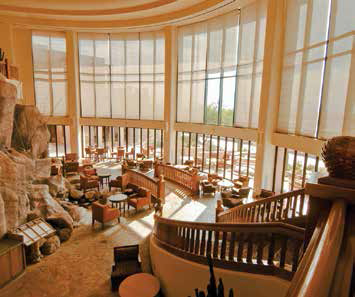
Saratoga Casino in Colorado features a cost-effective yet visually stunning chandelier composed of glass water bottles from the Saratoga Springs water company.
Energy efficiency will always be a crucial factor for casino design and management. However, comprehensive casino efficiency only comes when owner/designer teams are willing to broaden the conversation and take a holistic, 360-degree approach to an economically efficient design that provides productive experiences for all stakeholders.
Kris Irwin is senior interior designer for JCJ Architecture, an architectural, planning and interior design firm with offices in New York, Connecticut, Massachusetts, Arizona and California. Before joining JCJ Architecture’s private practice, Mr Irwin was an interior designer for the Fontainebleau and Arizona State University’s owner and operator teams.






